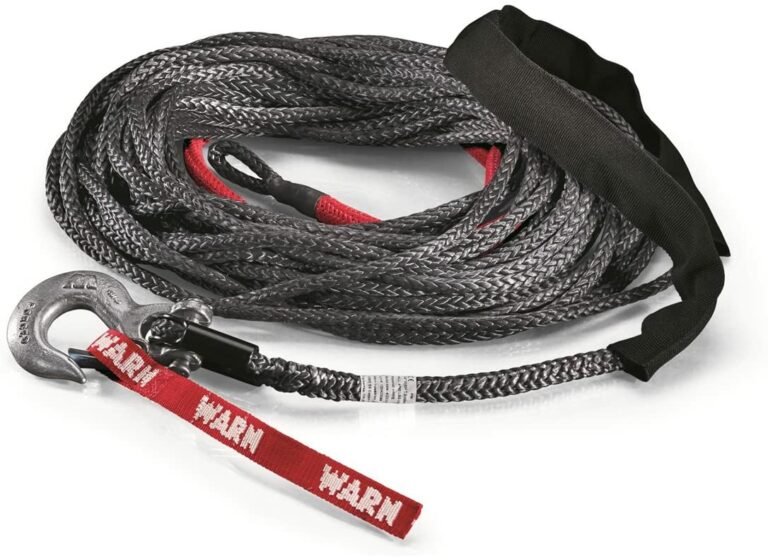Winch cables, the lifeline of every heavy-duty pulling operation, need to be well-maintained to ensure safety and efficiency. When a cable begins to fray or damage, it’s crucial to replace it to prevent potential accidents. The most critical step in this process is precisely cutting the cable. This guide aims to deliver a comprehensive understanding of this process.
Tools Required
The job of cutting steel winch cable demands specific tools that can withstand the toughness of the material and ensure a precise cut. Here’s what you need:
-
- Safety Glasses: Essential for shielding your eyes from potential harm due to minute steel fragments during the cutting process.
-
- Work Gloves: Crucial for protecting your hands from sharp cable ends and providing a better grip during cutting.
-
- Measuring Tape: Enables you to measure the exact length of the cable needed for your specific requirements.
-
- Marker: Helps in marking the precise spot on the cable where the cut needs to be made.
-
- Cable Cutters: The primary tool for this task, designed specifically for cutting through steel cables with ease and precision.
-
- Cable Clamps: Used post-cut to prevent the freshly cut steel cable from unravelling, ensuring it remains in perfect condition for use.
-
- Mallet/Hammer: Used in conjunction with the cable clamps to secure them onto the cable, ensuring a firm and secure fit.
How to Cut Steel Winch Cable?
Cutting a steel winch cable requires careful steps to ensure the cable’s longevity and user safety. Follow these detailed instructions for a precise and secure cut:
Step 1: Measurement
-
- Use a measuring tape to determine the required length of the cable to cut. Accuracy is crucial to avoid wastage or cutting the cable too short for your needs.
-
- Mark the precise spot on the cable where you intend to make the cut using a marker.
Step 2: Initial Cut
-
- Position the steel winch cable on a stable surface, such as a wooden block, to prevent unnecessary movement during the cutting process.
-
- With heavy-duty wire cutters, make two distinct cuts encircling the cable entirely at the marked spot. This isolates the section you want to remove.
Step 3: Scoring the Insulation
-
- Use a sharp knife to score the insulation around the diameter of each cut. These shallow cuts break the outer layer of the cable, ensuring a cleaner cut and preventing fraying.
Step 4: Slicing
-
- Place the wooden block on top of one of the cuts and apply firm but controlled pressure to hold the cable in place.
-
- Using the sharp knife, make slow and deliberate slicing motions through the insulation. Allow the blade to penetrate the cable’s layers, ensuring an even and precise cut. Repeat this step for the other side of the cable.
Step 5: Separation
-
- Gently pull apart the cut ends of the cable to separate the two pieces. Take care to handle the freshly cut ends cautiously, as they may have sharp edges.
Step 6: Using Cable Clamps
-
- To prevent unraveling and maintain the cable’s integrity, place a cable clamp on each cut end.
-
- Using a mallet or hammer, tighten the cable clamps securely onto the cable. This ensures a reliable connection and prevents fraying.
Step 7: Inspecting and Testing
-
- Inspect the cut ends for any sharp edges, fraying, or damage. Smooth out rough areas using a file or sandpaper to enhance safety.
-
- Before using the cable, conduct a thorough test to ensure it is securely connected and functioning correctly within the winch system.
-
- By following these step-by-step instructions, you can achieve a precise and secure cut on your steel winch cable, ensuring its longevity and maintaining safety during winching operations.
Additional Tips and Insights from Personal Experience
-
- Cutting Technique: Some users recommend taping the cable before cutting to prevent fraying. A sharp chisel and a few firm strikes can also do the job. Another method suggested is using a handheld grinder or a dremel tool to cut the cable.
-
- Cable Management: To avoid cable stress or potential breakage, avoid running the winch up to the hook excessively.
-
- Winch Saver: Many users recommend using a winch saver or rubber stopper, like the ones available at Cabela’s[1]. These devices reduce the stress on the cable when winching, extending the cable’s life. It’s worth noting that the shape and size of these winch savers may resemble a hockey puck.
-
- Backup Solutions: Always carry a few extra “U” shaped cable clamps and a tie-down strap. These can serve as quick fixes in case the cable snaps unexpectedly.
-
- Synthetic Cables: Some users are switching to synthetic ropes, recommended by many dealers as a durable, last long and safer alternative to steel. I wrote a detailed article comparing steel cable vs synthetic rope, you find this article helpful
Summary
Mastering the skill of accurately cutting a steel winch cable is critical for anyone routinely involved in winching operations. The process may seem challenging initially, but with the correct tools at hand and a careful, patient approach, you can ensure a clean, fray-free cut. This competence not only prolongs the lifespan of your cables but also significantly improves the safety and efficiency of your winching tasks.
References
-
Warn Winch bump stop | Cabela’s. (n.d.). https://www.cabelas.com/shop/en/warn-winch-bump-stop

